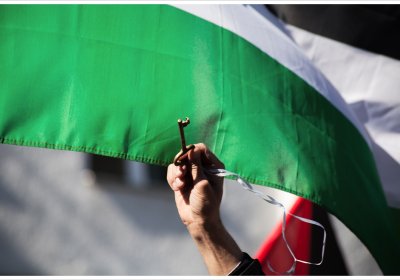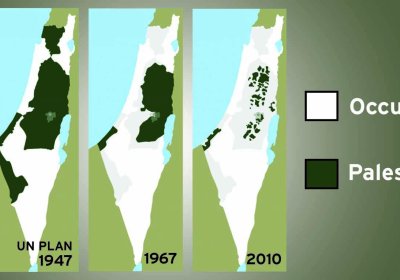The attempt to suppress official documentation of the ethnic cleansing of Palestinians in 1948 is not new, writes Ilan Pappe.
Palestine
Palestinian leaders have criticised US President Donald Trump’s much-hyped and long-awaited vision for Middle East peace, unveiled on June 25 in Bahrain, as more neo-colonialist containment.
Palestinian solidarity activists rallied in Sydney on May 11, commemorating al Nakba and calling for justice for Palestine.
While the Nakba began with the expulsion of Palestinians from their villages and the destruction of those villages, it continues with sniper attacks on Palestinians in Gaza, encroachment of illegal settlements across the West Bank and extreme limitations placed on Palestinians' movements within and between towns, courtesy of IDF-staffed checkpoints, writes Lisa Gleeson.
An Israeli government-backed propaganda initiative is attempting to rig another online poll about whether there should be a boycott of the Eurovision Song Contest in Tel Aviv later this month.
This desperate effort to manipulate public opinion comes as Israeli organisers are struggling to unload thousands of unsold tickets to the event.
The documentary Palestine Underground follows a group of artists who are challenging divisions between Palestinians living in the West Bank and those in Israel through the dance floor.
Hip hop, techno, trap and traditional music nurture new and known cultural impulses among Palestinians on either side of Israel’s West Bank wall, ushering in a new era of resistance.
Palestinians will gather to commemorate Land Day on March 30. Last year, Land Day marked the beginning of the Great March of Return weekly protests in Gaza.
Land Day has its origins in 1976 when Israeli authorities conducted a brazen, large-scale theft of Palestinian land on behalf of settlers. Palestinians responded with a general strike and protests.
The United Nations Human Rights Council (UNHRC) met on March 18 to investigate the human rights situation in Palestine and issued a report that focused on the impact of the occupation on the environment and natural resources, the ongoing use of excessive force by Israeli security forces against demonstrators in Gaza, and the near-humanitarian catastrophe in the territory caused by the blockade.
The Israeli city of Tel Aviv is preparing to host the Eurovision Song Contest in May, following Israeli artist Netta Barzilai’s win in Eurovision 2018.
In response, BDS Australia, which support the global boycott, divestment and sanctions campaign against Israel, says: “As a serial human rights abuser, it is unacceptable for Israel to be the host country for a competition that, in SBS’s own words, is supposed to ‘bring people and cultures together’.
Four months after her release from an Israeli prison, Palestinian poet and photographer Dareen Tatour received the Oxfam Novib PEN Award for Freedom of Expression in The Hague in January.
After US President Donald Trump recognised Jerusalem as the capital of Israel in 2018, Israel has ramped up its theft of the Palestinian land, writes Lisa Gleeson.
More than 60 international NGOs have added their voices in protest against the plan to hold the finals of the Eurovision Song Contest in Tel Aviv this year. They are now part of what is quickly becoming an international campaign by civil society groups seeking to move the event, which is scheduled for May, from Israel.
- Previous page
- Page 16
- Next page











